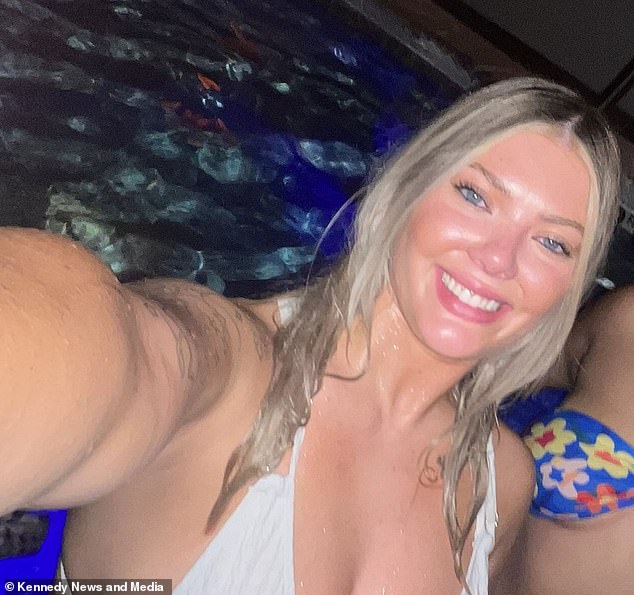Texas woman goes BLIND after common contact lens mistake led to parasites burrowing in her eyeball
A Texas woman who is blind in her right eye is urging others not to make the same mistake they made with contact lenses.
Brooklyn McCasland, 23, started experiencing the “worst pain she had ever felt” a few days after a trip to the beach with friends in Alabama in August.
The barista was first told by doctors that she just had sand in her eye, then they blamed it on a common infection and gave her eye drops and antibiotics.
But the pain persisted for weeks. The outer layer of her eye began to cloud, with what her doctor assumed was damage from an infection.
She was referred to a specialist, who scanned her eye and saw specks of white, cloudy material, and determined that parasites had burrowed into the young woman’s cornea.
It is thought she contracted the parasites – which live in tap water, oceans and lakes – after swimming in the sea with her contact lenses.
McCasland said, “If I could have avoided all this pain by not swimming in my lenses, I would have.”
McCasland had to stop work at the cafe due to the infection. The pain, which had lasted for a month and a half, made it difficult to work, as did the loss of vision in her left eye, which caused changes in depth perception.
She has lost the sight in her right eye and is awaiting an expensive transplant that has only a small chance of restoring her sight.
The parasite, called acanthamoeba, lives in water and can enter the eye through microscopic tears in the cornea. The insects are between 15 and 45 nanometers in size, about 5,000 times smaller than the width of a human hair.
They burrowed into the clear outer layer of McCasland’s eyeball and bred, multiplied and ate the healthy tissue there.
It is estimated that 1,500 Americans develop this disease every year The Cleveland Clinic. About 90 percent of these cases occur in people who wear contact lenses.
That’s why ophthalmologists recommend not showering, swimming, or taking a hot tub with your lenses in.
When the pain started, McCasland went to her optometrist, who diagnosed her with a common eye infection and prescribed her antibiotics, a steroid eye drop and another eye drop for the pain.

In acanthamoeba keratitis, the parasites burrow into the cornea and begin to multiply, causing sharp pain, blurred vision, light sensitivity, and in some cases blindness. The cloudiness seen on this eye scan is the damage the insects have done to her cornea
She said it started with a pain that “felt like there was glass in your eye.”
Then after several weeks her vision started to become blurry.
‘She [the doctors] still had nothing.
‘They were still shooting in the dark, which was very frustrating. I remember praying.”
After about a month and a half of persistent pain and no answers, McCasland went to a specialist whose office was four hours away from hers.
There, after they did scans of her eye, it was determined that she had acanthamoeba keratosis, the technical name for the infection.
She said: ‘It was a shock but also a relief that everything was answered. Been misdiagnosed for so long and not knowing what it is, and it’s getting worse and I’m in pain.”
If doctors detect the condition early enough, they can easily treat it with eye drops, which contain chlorine to kill the parasites.
McCasland has been given a series of these eye drops, which contain some of the products also used to clean swimming pools, and which she has to take every 30 minutes throughout the day.
In about 40 percent of cases, doctors need to perform surgery: scraping the outside of the eye to remove the parasites and later repairing the area through a transplant.

McCasland said that in the 16 years she wore contact lenses, she never took them out when she went to the pool or showered. She now said she wished she had been warned. She said: ‘Now that my sight is gone I would do anything to get it back. It would certainly be life-changing.”
McCasland is one of the unfortunate people who will likely have to undergo surgery. She is currently awaiting a $5,000 cornea transplant, on top of a $62,000 bill for all the various medications.
Since this diagnosis, she has reflected on her almost twenty years of contact use.
She said she always wore them when showering and swimming, and that she also rinsed her socket with tap water.
She recalled that during previous visits to her optometrist, the doctor had asked her if she had showered with her lenses. He replied, “Yes, some people get away with it. It’s not really a big problem’.
This was frustrating for her. She said: ‘That upset me, especially after I found out I actually had it.’ She wants people to be aware that this condition, while rare, can affect anyone, even those who don’t wear contact lenses.
As a result of the debilitating condition, McCasland was forced to leave work.
The loss of vision in one eye has distorted her depth perception and getting sunlight in her eyes is painful – both aspects that make working in a well-lit cafe almost impossible.
So a friend has one GoFundMe to help the young woman pay bills while she waits for surgery, as Texas does not offer temporary disability.
